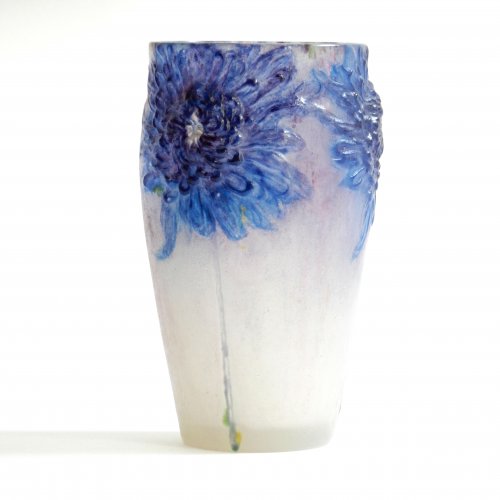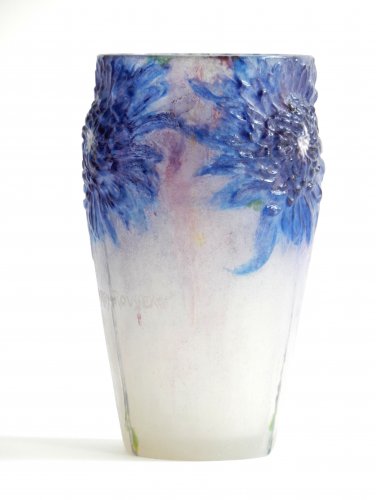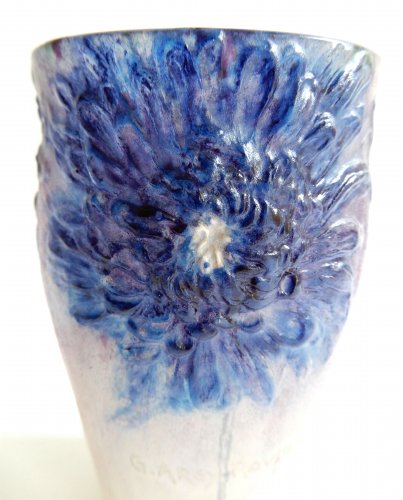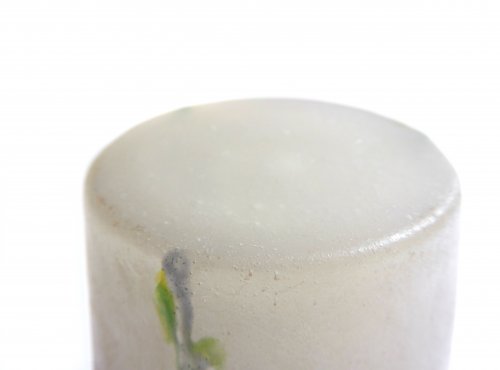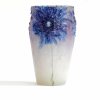Gabriël Argy-Rousseau (1885-1953) Vase 'Chrysanthemes'
About this piece
Beautiful vase made by the famous glass artist Gabriel Argy-Rousseau.De vase is not called 'Chrysanthèmes' for nothing, three chrysanthèmes in full bloom, with a deep blue and purple colour, a white heart and a soft green stem are beautifully depicted in relief. The light base varies in colour from white to soft pink, amethyst and green.
Argy is counted among the great glass artists who worked with the difficult material pâte de verre. This 1919 vase is a fine example of his creativity and craftsmanship. His designs were always made in a small series, mostly by hand, so his works are always quite rare and precious.
The vase is signed with 'G. Argy-Rousseau', the bottom is also signed with 'France'.
Biography:
Joseph-Gabriel Argy-Rousseau (Meslay-le-Vidame 1885-1953) is considered as one of the few major glass artists that worked with pâte de verre. Pâte de verre was rediscovered just at the end of the 19th century by Henri Cros and Georges Despret. But a small number of artists developed their own methods and recipe and specialized in working with pâte de verre. Together with Henri Cros, Georges Despret, François Décorchemont and Amalric Walter, Gabry-Rousseau is seen as one of the greatest glass artists in the field of pâte de verre. He developed within the pâte de verre also the so-called "pâte the crystal," which had as its main characteristic that it was more transparent.
Because of his friendship on the Academy in Sèvres (l’Ecole Nationale de Ceramique de Sèvres) with Jean Cros, the son of Henri Cros, Argy-Rousseau learned to work with pâte de verre. Since then he used pâte de verre as the basis for all his designs.
Argy-Rousseau began exhibiting in 1914 at the Exposition du Salon des Artistes Français and quickly gained success and fame due to multiple enthusiastic reviews of his work.
In 1921, he started his own studio in Paris. "Les pâtes de verres d'Argy-Rousseau". The financier and gallery owner Gustave Moser-Millot got the exclusive rights of sale. He remained all his life on a small scale making glass, most items were mainly hand-produced, but there also were semi-automated techniques applied to the simpler designs.
His designs were always produced in small series. In 1925, he was at the top of his fame. Yet he was partly due to the economic crisis forced to close his studio in 1931. After this, he started working as an independent artist in a small studio and made unique pieces only. He lived in great poverty but remained active.
He died in 1953. Argy-Rousseau's work is quite rare and wanted. Many private collectors and museums have pieces of Argy-Rousseau in their collections.
Literature:
* Janine Bloch Dermant, 'Gabriel Argy-Rousseau, Les pâtes de verre catalogue raisonné', Les Éditions de l'amateur, Paris 1990. P. 47 en 180.
* Philippe Olland; 'Dictionnaire des Maîtres Verriers de l'Art Nouveau á l'Art Déco Marques & signatures', Éditions Faton 2016. P. 30 t/m 33.
* Victor Arwas, 'Glas, Art Nouveau to Art Deco', Academy Editions London 1987. P. 26 t/m 35.
Condition
Excellent
Material:
Pâte de verre
Measurements:
Height: 14,5 cm
(5,71")
Neck diameter: 7,8 cm
(3,07")
Year:
1919
Origin:
France
Artist / atelier:
Gabriël Argy-Rousseau,

